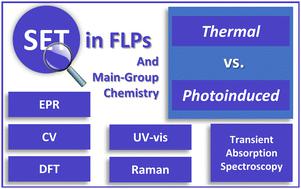当前位置:
X-MOL 学术
›
Chem. Soc. Rev.
›
论文详情
Our official English website, www.x-mol.net, welcomes your feedback! (Note: you will need to create a separate account there.)
Mechanistic studies on single-electron transfer in frustrated Lewis pairs and its application to main-group chemistry
Chemical Society Reviews ( IF 46.2 ) Pub Date : 2024-04-16 , DOI: 10.1039/d4cs00185k Lars J. C. van der Zee 1 , Jelle Hofman 1 , Joost M. van Gaalen 1 , J. Chris Slootweg 1
Chemical Society Reviews ( IF 46.2 ) Pub Date : 2024-04-16 , DOI: 10.1039/d4cs00185k Lars J. C. van der Zee 1 , Jelle Hofman 1 , Joost M. van Gaalen 1 , J. Chris Slootweg 1
Affiliation

|
Advances in the field of frustrated Lewis pair (FLP) chemistry have led to the discovery of radical pairs, obtained by a single-electron transfer (SET) from the Lewis base to the Lewis acid. Radical pairs are intriguing for their potential to enable cooperative activation of challenging substrates (e.g., CH4, N2) in a homolytic fashion, as well as the exploration of novel radical reactions. In this review, we will cover the two known mechanisms of SET in FLPs—thermal and photoinduced—along with methods (i.e., CV, DFT, UV-vis) to predict the mechanism and to characterise the involved electron donors and acceptors. Furthermore, the available techniques (i.e., EPR, UV-vis, transient absorption spectroscopy) for studying the corresponding radical pairs will be discussed. Initially, two model systems (PMes3/CPh3+ and PMes3/B(C6F5)3) will be reviewed to highlight the difference between a thermal and a photoinduced SET mechanism. Additionally, three cases are analysed to provide further tools and insights into characterizing electron donors and acceptors, and the associated radical pairs. Firstly, a thermal SET process between LiHMDS and [TEMPO][BF4] is discussed. Next, the influence of Lewis acid complexation on the electron acceptor will be highlighted to facilitate a SET between (pBrPh)3N and TCNQ. Finally, an analysis of sulfonium salts as electron acceptors will demonstrate how to manage systems with rapidly decomposing radical species. This framework equips the reader with an expanded array of tools for both predicting and characterizing SET events within FLP chemistry, thereby enabling its extension and application to the broader domain of main-group (photo)redox chemistry.
中文翻译:

受挫路易斯对单电子转移机理研究及其在主族化学中的应用
受挫路易斯对(FLP)化学领域的进展导致了自由基对的发现,这是通过从路易斯碱到路易斯酸的单电子转移(SET)获得的。自由基对因其以均裂方式协同激活具有挑战性的底物(例如CH 4、N 2)以及探索新型自由基反应的潜力而令人着迷。在这篇综述中,我们将介绍 FLP 中 SET 的两种已知机制(热诱导和光诱导),以及预测该机制并表征所涉及的电子供体和受体的方法(即CV、DFT、UV-vis)。此外,还将讨论用于研究相应自由基对的可用技术(即,EPR、UV-vis、瞬态吸收光谱)。首先,将审查两个模型系统(PMes 3 /CPh 3 +和 PMes 3 /B(C 6 F 5 ) 3),以突出热和光诱导 SET 机制之间的差异。此外,还分析了三个案例,以提供进一步的工具和见解来表征电子供体和受体以及相关的自由基对。首先,讨论了LiHMDS和[TEMPO][BF 4 ]之间的热SET过程。接下来,将强调路易斯酸络合对电子受体的影响,以促进 ( p BrPh) 3 N 和 TCNQ之间的 SET 。最后,对作为电子受体的锍盐的分析将演示如何管理具有快速分解自由基物质的系统。该框架为读者提供了一系列扩展的工具,用于预测和表征 FLP 化学中的 SET 事件,从而使其能够扩展到更广泛的主族(光)氧化还原化学领域。
更新日期:2024-04-16
中文翻译:

受挫路易斯对单电子转移机理研究及其在主族化学中的应用
受挫路易斯对(FLP)化学领域的进展导致了自由基对的发现,这是通过从路易斯碱到路易斯酸的单电子转移(SET)获得的。自由基对因其以均裂方式协同激活具有挑战性的底物(例如CH 4、N 2)以及探索新型自由基反应的潜力而令人着迷。在这篇综述中,我们将介绍 FLP 中 SET 的两种已知机制(热诱导和光诱导),以及预测该机制并表征所涉及的电子供体和受体的方法(即CV、DFT、UV-vis)。此外,还将讨论用于研究相应自由基对的可用技术(即,EPR、UV-vis、瞬态吸收光谱)。首先,将审查两个模型系统(PMes 3 /CPh 3 +和 PMes 3 /B(C 6 F 5 ) 3),以突出热和光诱导 SET 机制之间的差异。此外,还分析了三个案例,以提供进一步的工具和见解来表征电子供体和受体以及相关的自由基对。首先,讨论了LiHMDS和[TEMPO][BF 4 ]之间的热SET过程。接下来,将强调路易斯酸络合对电子受体的影响,以促进 ( p BrPh) 3 N 和 TCNQ之间的 SET 。最后,对作为电子受体的锍盐的分析将演示如何管理具有快速分解自由基物质的系统。该框架为读者提供了一系列扩展的工具,用于预测和表征 FLP 化学中的 SET 事件,从而使其能够扩展到更广泛的主族(光)氧化还原化学领域。



























 京公网安备 11010802027423号
京公网安备 11010802027423号